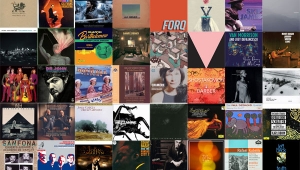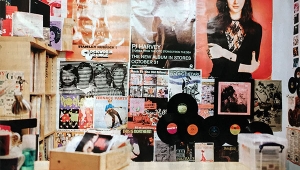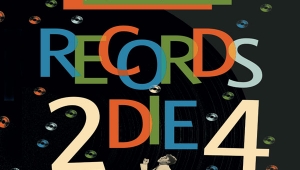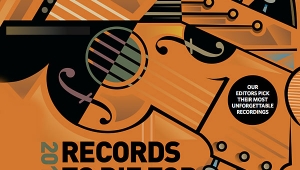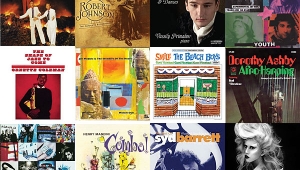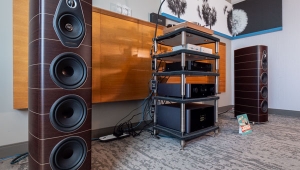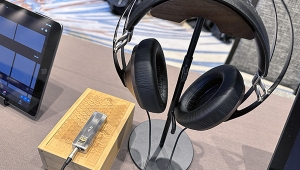| Columns Retired Columns & Blogs |
2003 Records To Die For Page 3
Thomas Conrad
WOODY SHAW: Rosewood
Woody Shaw, trumpet, flugelhorn; Art Webb, James Spaulding, flute; Frank Wess, flute, piccolo; James Vass, soprano & alto sax; Gary Bartz, alto sax; Carter Jefferson, René McLean, soprano & tenor sax; Joe Henderson, tenor sax; Janice Robinson, Curtis Fuller, trombone; Steve Turre, trombone, bass trombone; Lois Colin, harp; Onaje Allan Gumbs, piano, electric piano; Larry Willis, piano; Clint Houston, Stafford James, bass; Victor Lewis, drums; Sammy Figueroa, congas; Armen Halburian, Nana Vasconcelos, percussion; Judi Singh, vocal
Columbia/Legacy CK 65519 (CD). 1998. Michael Cuscuna, original & reissue prod.; Don Puluse, eng.; Mark Wilder, mastering. AAD? TT: 61:33
Rosewood was briefly famous long ago. It was Woody Shaw's major-label debut, was nominated for a Grammy, and was "Record of the Year" in the 1978 Down Beat Critics Poll. At the time, Rosewood promised to establish Shaw as the next major trumpet figure in jazz. But it all came unraveled. By 1981, Columbia had dropped Shaw from its roster. By 1983, Shaw had disbanded his group. By 1989, he was dead and all but forgotten at 44, a victim of the jazz life and his own demons. The first reissue of Rosewood came in a Mosaic boxed set in 1992. This 1998 Columbia/Legacy reissue, beautifully remixed and remastered by Mark Wilder, brings it all back again: Shaw's crackling brilliant brassiness and spitfire speed and startling intervallic leaps, all infused with lyric grace. One advantage of recording for Columbia was rehearsal time. Shaw's ambitious arrangements for expanded ensemble are realized with meticulous detail.
TOMASZ STANKO QUARTET: Matka Joanna
Tomasz Stanko, trumpet; Bobo Stenson, piano; Anders Jormin, bass; Tony Oxley, drums ECM 1544 (CD). 1995. Manfred Eicher, prod.; Jan Erik Kongshaug, eng. DDD. TT: 68:07
The music on this album was inspired by a Jerzy Kawalerowicz film called Matka Joanna od Aniolów, which premiered in Warsaw in 1961. The first of five extraordinary ECM recordings by Tomasz Stanko that have appeared since 1995, it came and went pretty much unnoticed when it was released. Now, with the benefit of hindsight, it's clear that Matka Joanna was the first evidence that Tomasz Stanko is our greatest living trumpet player. It is a rapt, mesmerizing, exquisitely sustained act of the imagination during which Stanko, surrounded by one of Europe's most creative rhythm sections, unfolds the full scope of his art: The vastness of his tonal and textural range. The depth and authenticity of his search for spiritual truth. The revelatory freshness of his forms. If what Stanko plays are clichés in Poland, then Poland is a far groovier place than we ever imagined. (XIX-6)
BOB DYLAN: Blood on the Tracks
Columbia PC 33235 (LP). 1974. Bob Dylan, prod.; Phil Ramone, eng. AAA. TT: 51:40
Blood on the Tracks isn't Dylan's most challenging or ambitious work, but sometimes the road less traveled is less traveled for a reason. Or: Just because something is accessible and incredibly popular doesn't mean it's not that good. I'm not a Bob Dylan fan, but Blood on the Tracks is that good. It's not full of important social commentary or outrage, but it's a beautifully crafted and performed collection of songs that represents the best work of Bob Dylan the singer, musician, and songwriter, if not of Bob Dylan the counterculture poet laureate. "If You See Her, Say Hello," "Shelter from the Storm," and "Tangled Up in Blue" are my favorite cuts, but there's not a weak song in the bunch. Plus, the sound on my Columbia LP is clean and open, with solid, tangible images and a nice spacious soundstage. (XXV-11)
NEIL YOUNG: Tonight's the Night
Reprise MS 2221 (CD). 1975. Neil Young, David Briggs, Elliot Mazer, prods.; Tim Mulligan, prod., eng. AAD. TT: 44:32
If ever there were an album tailor-made for late-night introspection, it's Tonight's the Night. Raw and emotional, this album represents Neil Young's own introspection in the wake of the overdose deaths of two friends, Crazy Horse guitarist Danny Whitten and roadie Bruce Berry. The songs—particularly the two versions of the title cut that bookend the album—are incredibly powerful in their ragged bleakness, and "Borrowed Tune" is a crystal-clear window into the tired sadness that permeated Young's heart and soul. The musicianship is deliberately sloppy, which adds to the painful ambience, but the sound is anything but sloppy. It's first-rate—clear, clean, and powerful. Tonight's the Night is a mainline into darkness and despair—it isn't pretty, but it will definitely touch your soul. Be prepared: It's impossible to listen to this album and not pass judgment on yourself. (XIX-2)
THE BAKER'S WIFE: Original Cast
Stephen Schwartz, music & lyrics; Robert Billig, cond.
Original Cast THT CD 891 (CD). 1976/1997. Stephen Schwartz, Doris Chu, Bruce Yeko, prods.; Fred Miller, Greg Calbi, James P. Shelton, engs. ADD? TT: 42:04
Okay, I admit it: the sound quality isn't even close to being in the top 10% of recordings available today. The voices are actually well-recorded, but the orchestral accompaniment sounds canned, and if you listen carefully you can hear the occasional editing glitch. But with all that, The Baker's Wife is most assuredly a Record To Die For. The reason: The score of this 1976 musical, which closed before reaching Broadway, is about as richly melodic as that of any written in the past 30 years. Paul Sorvino, best known for playing mobsters, stars as the Baker, and turns out to have a lovely tenor voice. He's heartbreaking in "If I Have to Live Alone." Patti LuPone plays the title role, and does "Meadowlark" (which has become a musical-theater standard) with the involvement and emotional intensity that are her trademarks. The Baker's Wife has been reworked by its authors several times over the years—most recently in November 2002, at the Goodspeed Opera House's Norma Terris Theater, for a production starring Christiane Noll and Lenny Wolpe—and, given the current drought of good musicals, it may get to Broadway yet. There is also available a two-CD set from Jay Records of the 1990 London cast, which is better recorded but singularly lacking in charm. If you want to experience the magic of The Baker's Wife, the recording to get is this one, from Bruce Yeko's Original Cast Records, keepers of the musical-theater flame.
RENÉE FLEMING: Bel Canto
Arias from operas by Bellini, Donizetti, Rossini
Patrick Summers, Orchestra of St. Luke's; with Kristine Jepson, mezzo-soprano
Decca 467 101-2 (CD). 2002. Eric Smith, prod.; Tom Lazarus, Graham Meek, engs. DDD. TT: 71:45
It used to be said that in order to succeed as an opera singer you needed three things: voice, voice, and voice. The requirements have changed in today's opera world, and while soprano Renée Fleming's assets include a keen musical intelligence, a facility with languages, and a strikingly attractive appearance, I think she would have had no trouble succeeding under the old rules. She makes an absolutely gorgeous sound, the voice darker in the middle and lower part of the range than that of, say, Caballé, Sutherland, or Sills, which normally means that the singer is not going to be at her best at the top. But not in Fleming's case. It's amazing how, after singing low-lying passages with a richness that approaches the sound of a mezzo, her voice opens up as it reaches the range around high C and beyond, and she's able to toss off coloratura runs and floating notes with an ease that recalls Caballé in her prime. Recommended to all lovers of the female voice. Excellent sound. (XXV-12)
BILL EVANS: New Conversations
Bill Evans, piano, electric piano
Warner Bros. 3177-2 (CD). 1978/1997. Helen Keane, prod.; Frank Laico, eng. ADD. TT: 46:20
Compared to its famous predecessor, Conversations with Myself, Bill Evans' third volume of overdubbed piano improvisations tends to be underrated. By 1978, the aching introspection and fragile beauty that characterized Evans' earlier work had given way to a bolder, more assertive and uplifting mode of expression. Listen to his subtle key changes in "For Nennette," his exquisitely timed out-of-tempo melody statements in "Song for Helen," his ravishing reharmonizations of Duke Ellington's "Reflections in D" and Cy Coleman's "I Love My Wife," and you'll understand why Evans, by all accounts, considered New Conversations his finest album. If his use of the Fender Rhodes electric piano for extra color seems a tad dated now, at least he didn't play Clavinet!
WAGNER: Orchestral Music
Die Walküre: "Wotan's Farewell," "Magic Fire Music." Parsifal: "Good Friday Spell," Act III Synthesis.
Leopold Stokowski, Houston Symphony Orchestra
Everest EVC 9024 (CD). 1959/1995. Bert Whyte, prod., eng. ADD. TT: 45:32
It's a bird, it's a plane, it's SuperWagner! Did Leopold Stokowski hire the 101 Strings to supplant his trusty Houston forces? Where did all those extra harps come from? Is that a female choir intoning "ahhh ahhh ahhh" like guardian angels during the "Magic Fire Music"? Has this music ever come across to such drop-dead gorgeous effect before or since? Mark Twain once quipped that Wagner's music is "better than it sounds." Not here, that's for sure. Producer Bert Whyte's 1959 sound, vividly captured on 35mm film and superbly transferred to CD, retains its freshness.
THE KENTUCKY COLONELS: Appalachian Swing
World Pacific 1821 (LP). 1964. Richard Bock, prod., eng.; Ed Pearl, prod. AAA. TT: 26:58
The Kentucky Colonels were neither—the core members were young Californians of French-Canadian birth—but the brilliance of their musicianship remains influential among bluegrassers. In particular, Roland White (mandolin) and his brother Clarence (guitar) were gifted soloists whose phrasing and melodic ideas seemed endlessly fresh.
MARTIN NEWELL: The Greatest Living Englishman
Humbug/Cherry Red CDMRED 171 (UK CD). 1992. Andy Partridge, prod., eng. DDD. TT: 46:20
Ten years after its release, this intelligent, passionate record still stands as Martin Newell's masterpiece, and one of the best pop albums ever made. It's instantly accessible: catchy and hook-laden, but with melodic depth and a perfect balance between a signature sound (jangly guitar rock) and more varied instrumental settings (the latter thanks to producer Andy Partridge of XTC).
AEROSMITH: Rocks
Columbia CK 57363 (CD). 1976. Aerosmith, Jack Douglas, prods.; Jay Messina, eng.; Rod O'Brien, Sam Ginsberg, asst. engs. AAD? TT: 34:34
When was the last time you heard a rock album that was all killer, no filler? A long time, I'm sure. Aerosmith's mid-'70s heyday featured two such discs: Toys in the Attic and Rocks. They were much shorter than albums are today, but that's not necessarily a bad thing. Rocks—an album title that's an all-time high watermark for truth in advertising—finds the band at the height of its powers, leaning hard into such songs as "Back in the Saddle," "Last Child," and "Lick and a Promise." Rocks is full-tilt riff rock at its loud, lascivious best.
PAT METHENY & LYLE MAYS: As Falls Wichita, So Falls Wichita Falls
Pat Metheny, electric & acoustic guitars, bass; Lyle Mays, piano, synthesizer, organ, autoharp; Nana Vasconcelos, berimbau, percussion, drums, vocals
ECM 1190 (CD). 1981. Manfred Eicher, prod.; Jan Erik Kongshaug, eng. AAD? TT: 43:36
If you've spent any time driving the back roads of the plains states, you know how essential good driving music is. On the one hand, you need the sort of mix tape that will keep you awake during especially long hauls. At other times, you simply want something that evokes the spirit of the land outside your windshield. The title track of this 1981 collaboration between guitarist Metheny, keyboardist Mays, and percussionist-vocalist Nana Vasconcelos is a Midwestern answer to Kraftwerk's "Autobahn," bringing to mind the tail end of an all-night drive, with the sun just beginning to color the Eastern sky and nothing for you to stare at but the road as it extends out to the horizon.
THE HEART AND SOUL OF BERT BERNS: Various Artists
Universal 440 064 795-2 (CD). 2002. Doug Morris, prod. ADD. TT: 28:09
This 10-track disc spotlights the producer, songwriter, and Bang Records executive who, though born of Russian-Jewish immigrants, helped create some of the greatest 1960s soul music for such artists as Solomon Burke, the Drifters, Otis Redding, and Irma Thomas. He also produced Neil Diamond and Van Morrison, among others. Under his own or his pen name, Bert Russell (his middle name), Berns co-wrote "Twist and Shout" for the Isley Brothers, "Piece of My Heart" (with Jerry Ragovoy) for Irma Thomas, and "Cry Baby" (with Norman Meade) for Garnet Mimms. He wrote "Cry to Me" for Solomon Burke and "Are You Lonely for Me Baby" for Freddie Scott. These familiar tunes have been covered by Janis Joplin, the Beatles, the Rolling Stones, and many others, and that's only a small part of his unusual legacy.
HOWARD TATE: Howard Tate's Reaction
Gerry Thomas, Arthur Jenkins, arrangers
Turntable TTS-5002 (LP). 1970. Lloyd Price, Johnny Nash, prods.; Wiley Brooks, Herbert Abramson, engs. AAA. TT: 30:45
This one's really worth dying for. Its existence is more rumor than fact—only a few hundred copies were thought to have been pressed. Missing and presumed dead, the legendary 59-year-old soul singer surfaced a few years ago and quickly reunited with producer-songwriter Jerry Ragovoy, who wrote, among other tunes for Tate, "Get It While You Can," later covered by Janis Joplin, and "Look at Granny Run Run," reworked by Ry Cooder. Depending on whether the jacket or the label is correct, this brief 12-song set, issued on Lloyd Price's Turntable Records, was recorded either in Jamaica or at Price's 1674 Broadway Turntable nightspot. Wherever, you can't have it anyway. But while we wait for the Ragovoy-Tate comeback album, you can have Get It While You Can: The Legendary Sessions—a 1995 CD compilation that's much better anyway, even if, unlike this rarity, it's just not to die for.
DIVINE SECRETS OF THE YA-YA SISTERHOOD: Original Soundtrack
DMZ/Columbia CK 86534 (CD). 2002. T Bone Burnett, prod.; Callie Khouri, exec. prod.; Gavin Lurssen, Josh Florian, mastering. DDD? TT: 63:03
T Bone Burnett stirred the music world when his soundtrack for O Brother, Where Art Thou? took top awards, even though disc jockeys refused to play the album. Burnett's talents for blending different artists—Blind Uncle Gaspard, Bob Dylan, Mahalia Jackson, Ray Charles, Lauryn Hill, the Thompsons, Ann Savoy, Bob Schneider, Richard and Linda Thompson, and Alison Krauss—and musical genres (folk, Cajun, blues, jazz, alternative rock, rap) really pays off in the soundtrack to Divine Secrets of the Ya-Ya Sisterhood. The album begins with "Sitting in the Window of my Room," sung in French and taken from a scratchy, lo-fi 78rpm recording of Blind Uncle Gaspard. This is authentic! Modern, audiophile sonic values are evident elsewhere, when the same tune is sung in English by Alison Krauss. One can clearly discern the distinct musical character of the delicate hammer dulcimer from the lap-steel guitar and tack piano in the opening of this track. I was pleased to find Richard and Linda Thompson singing a duet in "Dimming of the Day," producing the most beguilingly sweet, sad, and beautiful melody.
ORCHESTRA BAOBAB: Pirate's Choice
Rudolphe Gomis, vocals; Barthelemy Attisto, guitar; Balla Sidibe, vocals, timbales; Charley N'Diaye, bass; Mountaga Kouyate, percussion, tumba
World Circuit/Nonesuch 79643-2 (2 CDs). Moussa Diallo, prod.; John Hadden, Tom Leader, Adam Skeaping, remastering. AAD? TT: 94:49
Orchestra Baobab is a Senegalese band that began in the 1960s, playing for diplomats at the exclusive Dakar nightclub of the same name. Released on cassette in 1982, this studio recording has achieved legendary status among those who treasure West African music. Creating a fusion of Cuban rhythms and African folk melodies, Baobab's eight musicians transported me to me that steamy nightclub, where I rode on Barthelemy Attisto's smooth, semi-psychedelic guitar improvisations. The album opens with "Utrus Horas," a slow, sensuous, atmospheric Cuban tune. Superb imaging can be heard on "Werente Serigne." The percussion is on the left, a droning blend of singers on the right, with the main singer and a syncopated tenor sax in the center. "Soldadi," a song from the Cassanance region of Senegal, is sensuous and hypnotic, alternating a vocalist with a woeful tenor sax in the center channel. This is world music at its lightest and coolest.
WOODY SHAW: Rosewood
Woody Shaw, trumpet, flugelhorn; Art Webb, James Spaulding, flute; Frank Wess, flute, piccolo; James Vass, soprano & alto sax; Gary Bartz, alto sax; Carter Jefferson, René McLean, soprano & tenor sax; Joe Henderson, tenor sax; Janice Robinson, Curtis Fuller, trombone; Steve Turre, trombone, bass trombone; Lois Colin, harp; Onaje Allan Gumbs, piano, electric piano; Larry Willis, piano; Clint Houston, Stafford James, bass; Victor Lewis, drums; Sammy Figueroa, congas; Armen Halburian, Nana Vasconcelos, percussion; Judi Singh, vocal
Columbia/Legacy CK 65519 (CD). 1998. Michael Cuscuna, original & reissue prod.; Don Puluse, eng.; Mark Wilder, mastering. AAD? TT: 61:33
Rosewood was briefly famous long ago. It was Woody Shaw's major-label debut, was nominated for a Grammy, and was "Record of the Year" in the 1978 Down Beat Critics Poll. At the time, Rosewood promised to establish Shaw as the next major trumpet figure in jazz. But it all came unraveled. By 1981, Columbia had dropped Shaw from its roster. By 1983, Shaw had disbanded his group. By 1989, he was dead and all but forgotten at 44, a victim of the jazz life and his own demons. The first reissue of Rosewood came in a Mosaic boxed set in 1992. This 1998 Columbia/Legacy reissue, beautifully remixed and remastered by Mark Wilder, brings it all back again: Shaw's crackling brilliant brassiness and spitfire speed and startling intervallic leaps, all infused with lyric grace. One advantage of recording for Columbia was rehearsal time. Shaw's ambitious arrangements for expanded ensemble are realized with meticulous detail.
TOMASZ STANKO QUARTET: Matka Joanna
Tomasz Stanko, trumpet; Bobo Stenson, piano; Anders Jormin, bass; Tony Oxley, drums ECM 1544 (CD). 1995. Manfred Eicher, prod.; Jan Erik Kongshaug, eng. DDD. TT: 68:07
The music on this album was inspired by a Jerzy Kawalerowicz film called Matka Joanna od Aniolów, which premiered in Warsaw in 1961. The first of five extraordinary ECM recordings by Tomasz Stanko that have appeared since 1995, it came and went pretty much unnoticed when it was released. Now, with the benefit of hindsight, it's clear that Matka Joanna was the first evidence that Tomasz Stanko is our greatest living trumpet player. It is a rapt, mesmerizing, exquisitely sustained act of the imagination during which Stanko, surrounded by one of Europe's most creative rhythm sections, unfolds the full scope of his art: The vastness of his tonal and textural range. The depth and authenticity of his search for spiritual truth. The revelatory freshness of his forms. If what Stanko plays are clichés in Poland, then Poland is a far groovier place than we ever imagined. (XIX-6)
Brian Damkroger
BOB DYLAN: Blood on the Tracks
Columbia PC 33235 (LP). 1974. Bob Dylan, prod.; Phil Ramone, eng. AAA. TT: 51:40
Blood on the Tracks isn't Dylan's most challenging or ambitious work, but sometimes the road less traveled is less traveled for a reason. Or: Just because something is accessible and incredibly popular doesn't mean it's not that good. I'm not a Bob Dylan fan, but Blood on the Tracks is that good. It's not full of important social commentary or outrage, but it's a beautifully crafted and performed collection of songs that represents the best work of Bob Dylan the singer, musician, and songwriter, if not of Bob Dylan the counterculture poet laureate. "If You See Her, Say Hello," "Shelter from the Storm," and "Tangled Up in Blue" are my favorite cuts, but there's not a weak song in the bunch. Plus, the sound on my Columbia LP is clean and open, with solid, tangible images and a nice spacious soundstage. (XXV-11)
NEIL YOUNG: Tonight's the Night
Reprise MS 2221 (CD). 1975. Neil Young, David Briggs, Elliot Mazer, prods.; Tim Mulligan, prod., eng. AAD. TT: 44:32
If ever there were an album tailor-made for late-night introspection, it's Tonight's the Night. Raw and emotional, this album represents Neil Young's own introspection in the wake of the overdose deaths of two friends, Crazy Horse guitarist Danny Whitten and roadie Bruce Berry. The songs—particularly the two versions of the title cut that bookend the album—are incredibly powerful in their ragged bleakness, and "Borrowed Tune" is a crystal-clear window into the tired sadness that permeated Young's heart and soul. The musicianship is deliberately sloppy, which adds to the painful ambience, but the sound is anything but sloppy. It's first-rate—clear, clean, and powerful. Tonight's the Night is a mainline into darkness and despair—it isn't pretty, but it will definitely touch your soul. Be prepared: It's impossible to listen to this album and not pass judgment on yourself. (XIX-2)
Robert Deutsch
THE BAKER'S WIFE: Original Cast
Stephen Schwartz, music & lyrics; Robert Billig, cond.
Original Cast THT CD 891 (CD). 1976/1997. Stephen Schwartz, Doris Chu, Bruce Yeko, prods.; Fred Miller, Greg Calbi, James P. Shelton, engs. ADD? TT: 42:04
Okay, I admit it: the sound quality isn't even close to being in the top 10% of recordings available today. The voices are actually well-recorded, but the orchestral accompaniment sounds canned, and if you listen carefully you can hear the occasional editing glitch. But with all that, The Baker's Wife is most assuredly a Record To Die For. The reason: The score of this 1976 musical, which closed before reaching Broadway, is about as richly melodic as that of any written in the past 30 years. Paul Sorvino, best known for playing mobsters, stars as the Baker, and turns out to have a lovely tenor voice. He's heartbreaking in "If I Have to Live Alone." Patti LuPone plays the title role, and does "Meadowlark" (which has become a musical-theater standard) with the involvement and emotional intensity that are her trademarks. The Baker's Wife has been reworked by its authors several times over the years—most recently in November 2002, at the Goodspeed Opera House's Norma Terris Theater, for a production starring Christiane Noll and Lenny Wolpe—and, given the current drought of good musicals, it may get to Broadway yet. There is also available a two-CD set from Jay Records of the 1990 London cast, which is better recorded but singularly lacking in charm. If you want to experience the magic of The Baker's Wife, the recording to get is this one, from Bruce Yeko's Original Cast Records, keepers of the musical-theater flame.
RENÉE FLEMING: Bel Canto
Arias from operas by Bellini, Donizetti, Rossini
Patrick Summers, Orchestra of St. Luke's; with Kristine Jepson, mezzo-soprano
Decca 467 101-2 (CD). 2002. Eric Smith, prod.; Tom Lazarus, Graham Meek, engs. DDD. TT: 71:45
It used to be said that in order to succeed as an opera singer you needed three things: voice, voice, and voice. The requirements have changed in today's opera world, and while soprano Renée Fleming's assets include a keen musical intelligence, a facility with languages, and a strikingly attractive appearance, I think she would have had no trouble succeeding under the old rules. She makes an absolutely gorgeous sound, the voice darker in the middle and lower part of the range than that of, say, Caballé, Sutherland, or Sills, which normally means that the singer is not going to be at her best at the top. But not in Fleming's case. It's amazing how, after singing low-lying passages with a richness that approaches the sound of a mezzo, her voice opens up as it reaches the range around high C and beyond, and she's able to toss off coloratura runs and floating notes with an ease that recalls Caballé in her prime. Recommended to all lovers of the female voice. Excellent sound. (XXV-12)
Jed Distler
BILL EVANS: New Conversations
Bill Evans, piano, electric piano
Warner Bros. 3177-2 (CD). 1978/1997. Helen Keane, prod.; Frank Laico, eng. ADD. TT: 46:20
Compared to its famous predecessor, Conversations with Myself, Bill Evans' third volume of overdubbed piano improvisations tends to be underrated. By 1978, the aching introspection and fragile beauty that characterized Evans' earlier work had given way to a bolder, more assertive and uplifting mode of expression. Listen to his subtle key changes in "For Nennette," his exquisitely timed out-of-tempo melody statements in "Song for Helen," his ravishing reharmonizations of Duke Ellington's "Reflections in D" and Cy Coleman's "I Love My Wife," and you'll understand why Evans, by all accounts, considered New Conversations his finest album. If his use of the Fender Rhodes electric piano for extra color seems a tad dated now, at least he didn't play Clavinet!
WAGNER: Orchestral Music
Die Walküre: "Wotan's Farewell," "Magic Fire Music." Parsifal: "Good Friday Spell," Act III Synthesis.
Leopold Stokowski, Houston Symphony Orchestra
Everest EVC 9024 (CD). 1959/1995. Bert Whyte, prod., eng. ADD. TT: 45:32
It's a bird, it's a plane, it's SuperWagner! Did Leopold Stokowski hire the 101 Strings to supplant his trusty Houston forces? Where did all those extra harps come from? Is that a female choir intoning "ahhh ahhh ahhh" like guardian angels during the "Magic Fire Music"? Has this music ever come across to such drop-dead gorgeous effect before or since? Mark Twain once quipped that Wagner's music is "better than it sounds." Not here, that's for sure. Producer Bert Whyte's 1959 sound, vividly captured on 35mm film and superbly transferred to CD, retains its freshness.
Art Dudley
THE KENTUCKY COLONELS: Appalachian Swing
World Pacific 1821 (LP). 1964. Richard Bock, prod., eng.; Ed Pearl, prod. AAA. TT: 26:58
The Kentucky Colonels were neither—the core members were young Californians of French-Canadian birth—but the brilliance of their musicianship remains influential among bluegrassers. In particular, Roland White (mandolin) and his brother Clarence (guitar) were gifted soloists whose phrasing and melodic ideas seemed endlessly fresh.
Appalachian Swing, which was recorded in just one evening, without overdubs, is something of an accidental landmark: When they gathered to make the album, the Colonels—who were singers as well as pickers—had no idea the producer intended to cut costs by leaving off the vocals and making an instrumental-only recording. Ironically or not, the songs they rearranged on the spot, including "Nine Pound Hammer" and "John Henry," are standouts.
AS has been reissued on LP (United Artists 29514, 1974) and CD (Rounder SS31, 1993), and while all are presently out of print, the latter is not too hard to find.
MARTIN NEWELL: The Greatest Living Englishman
Humbug/Cherry Red CDMRED 171 (UK CD). 1992. Andy Partridge, prod., eng. DDD. TT: 46:20
Ten years after its release, this intelligent, passionate record still stands as Martin Newell's masterpiece, and one of the best pop albums ever made. It's instantly accessible: catchy and hook-laden, but with melodic depth and a perfect balance between a signature sound (jangly guitar rock) and more varied instrumental settings (the latter thanks to producer Andy Partridge of XTC).
Martin Newell is nothing if not literate. Since the release of The Greatest Living Englishman he's become one of England's most widely read poets, thanks to his regular appearances in The Independent. His lyrics are moving and insightful, alternating autumnal regret with great, self-deprecating wit. You may enjoy his liner notes as much as his music.
Audioweenie warning: This recording was made on a DAT machine in Andy Partridge's garden shed, with all that that implies. The Greatest Living Englishman has been reissued by various small labels. Currently, the easiest to find of these is Cherry Red.
Daniel Durchholz
AEROSMITH: Rocks
Columbia CK 57363 (CD). 1976. Aerosmith, Jack Douglas, prods.; Jay Messina, eng.; Rod O'Brien, Sam Ginsberg, asst. engs. AAD? TT: 34:34
When was the last time you heard a rock album that was all killer, no filler? A long time, I'm sure. Aerosmith's mid-'70s heyday featured two such discs: Toys in the Attic and Rocks. They were much shorter than albums are today, but that's not necessarily a bad thing. Rocks—an album title that's an all-time high watermark for truth in advertising—finds the band at the height of its powers, leaning hard into such songs as "Back in the Saddle," "Last Child," and "Lick and a Promise." Rocks is full-tilt riff rock at its loud, lascivious best.
PAT METHENY & LYLE MAYS: As Falls Wichita, So Falls Wichita Falls
Pat Metheny, electric & acoustic guitars, bass; Lyle Mays, piano, synthesizer, organ, autoharp; Nana Vasconcelos, berimbau, percussion, drums, vocals
ECM 1190 (CD). 1981. Manfred Eicher, prod.; Jan Erik Kongshaug, eng. AAD? TT: 43:36
If you've spent any time driving the back roads of the plains states, you know how essential good driving music is. On the one hand, you need the sort of mix tape that will keep you awake during especially long hauls. At other times, you simply want something that evokes the spirit of the land outside your windshield. The title track of this 1981 collaboration between guitarist Metheny, keyboardist Mays, and percussionist-vocalist Nana Vasconcelos is a Midwestern answer to Kraftwerk's "Autobahn," bringing to mind the tail end of an all-night drive, with the sun just beginning to color the Eastern sky and nothing for you to stare at but the road as it extends out to the horizon.
Michael Fremer
THE HEART AND SOUL OF BERT BERNS: Various Artists
Universal 440 064 795-2 (CD). 2002. Doug Morris, prod. ADD. TT: 28:09
This 10-track disc spotlights the producer, songwriter, and Bang Records executive who, though born of Russian-Jewish immigrants, helped create some of the greatest 1960s soul music for such artists as Solomon Burke, the Drifters, Otis Redding, and Irma Thomas. He also produced Neil Diamond and Van Morrison, among others. Under his own or his pen name, Bert Russell (his middle name), Berns co-wrote "Twist and Shout" for the Isley Brothers, "Piece of My Heart" (with Jerry Ragovoy) for Irma Thomas, and "Cry Baby" (with Norman Meade) for Garnet Mimms. He wrote "Cry to Me" for Solomon Burke and "Are You Lonely for Me Baby" for Freddie Scott. These familiar tunes have been covered by Janis Joplin, the Beatles, the Rolling Stones, and many others, and that's only a small part of his unusual legacy.
A disc "to die for"? Friend and UNI executive Doug Morris compiled this odd, stingy set—some of it mastered from old vinyl—as a tribute to Berns, who died of heart failure at 38. So yes.
HOWARD TATE: Howard Tate's Reaction
Gerry Thomas, Arthur Jenkins, arrangers
Turntable TTS-5002 (LP). 1970. Lloyd Price, Johnny Nash, prods.; Wiley Brooks, Herbert Abramson, engs. AAA. TT: 30:45
This one's really worth dying for. Its existence is more rumor than fact—only a few hundred copies were thought to have been pressed. Missing and presumed dead, the legendary 59-year-old soul singer surfaced a few years ago and quickly reunited with producer-songwriter Jerry Ragovoy, who wrote, among other tunes for Tate, "Get It While You Can," later covered by Janis Joplin, and "Look at Granny Run Run," reworked by Ry Cooder. Depending on whether the jacket or the label is correct, this brief 12-song set, issued on Lloyd Price's Turntable Records, was recorded either in Jamaica or at Price's 1674 Broadway Turntable nightspot. Wherever, you can't have it anyway. But while we wait for the Ragovoy-Tate comeback album, you can have Get It While You Can: The Legendary Sessions—a 1995 CD compilation that's much better anyway, even if, unlike this rarity, it's just not to die for.
Larry Greenhill
DIVINE SECRETS OF THE YA-YA SISTERHOOD: Original Soundtrack
DMZ/Columbia CK 86534 (CD). 2002. T Bone Burnett, prod.; Callie Khouri, exec. prod.; Gavin Lurssen, Josh Florian, mastering. DDD? TT: 63:03
T Bone Burnett stirred the music world when his soundtrack for O Brother, Where Art Thou? took top awards, even though disc jockeys refused to play the album. Burnett's talents for blending different artists—Blind Uncle Gaspard, Bob Dylan, Mahalia Jackson, Ray Charles, Lauryn Hill, the Thompsons, Ann Savoy, Bob Schneider, Richard and Linda Thompson, and Alison Krauss—and musical genres (folk, Cajun, blues, jazz, alternative rock, rap) really pays off in the soundtrack to Divine Secrets of the Ya-Ya Sisterhood. The album begins with "Sitting in the Window of my Room," sung in French and taken from a scratchy, lo-fi 78rpm recording of Blind Uncle Gaspard. This is authentic! Modern, audiophile sonic values are evident elsewhere, when the same tune is sung in English by Alison Krauss. One can clearly discern the distinct musical character of the delicate hammer dulcimer from the lap-steel guitar and tack piano in the opening of this track. I was pleased to find Richard and Linda Thompson singing a duet in "Dimming of the Day," producing the most beguilingly sweet, sad, and beautiful melody.
ORCHESTRA BAOBAB: Pirate's Choice
Rudolphe Gomis, vocals; Barthelemy Attisto, guitar; Balla Sidibe, vocals, timbales; Charley N'Diaye, bass; Mountaga Kouyate, percussion, tumba
World Circuit/Nonesuch 79643-2 (2 CDs). Moussa Diallo, prod.; John Hadden, Tom Leader, Adam Skeaping, remastering. AAD? TT: 94:49
Orchestra Baobab is a Senegalese band that began in the 1960s, playing for diplomats at the exclusive Dakar nightclub of the same name. Released on cassette in 1982, this studio recording has achieved legendary status among those who treasure West African music. Creating a fusion of Cuban rhythms and African folk melodies, Baobab's eight musicians transported me to me that steamy nightclub, where I rode on Barthelemy Attisto's smooth, semi-psychedelic guitar improvisations. The album opens with "Utrus Horas," a slow, sensuous, atmospheric Cuban tune. Superb imaging can be heard on "Werente Serigne." The percussion is on the left, a droning blend of singers on the right, with the main singer and a syncopated tenor sax in the center. "Soldadi," a song from the Cassanance region of Senegal, is sensuous and hypnotic, alternating a vocalist with a woeful tenor sax in the center channel. This is world music at its lightest and coolest.
- Log in or register to post comments





